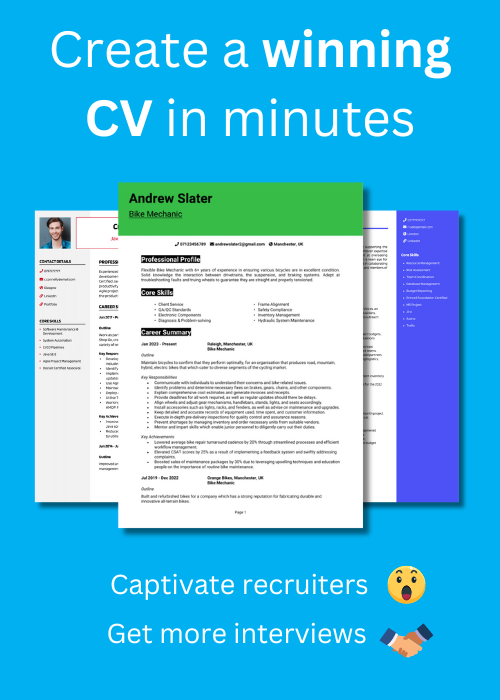IT skills are no longer optional on a CV – they’re essential.
I’ve recruited for roles where even strong candidates missed out simply because they couldn’t show the right technical skills.
And it’s not just about basic computer know-how anymore; many jobs demand specific software knowledge that proves you can keep up in a modern workplace.
To make sure you don’t get overlooked, I’ve pulled together 55 of the most valuable IT skills to add to your CV – organised by level and area of use, so you can highlight the ones that will really set you apart.
Basic IT skills
Even in non-technical roles, these foundational skills are essential. They help you complete daily tasks efficiently and show that you’re ready to hit the ground running in a modern workplace.
Word Processing
These are used daily in administrative and professional communications. Recruiters expect candidates to be confident with standard document creation tools.
- Microsoft Word – The longest-standing and most widely used word processor in the workplace. Proficiency with Word is essential for writing reports, letters, and formatted documents.
- Google Docs – A popular cloud-based alternative that allows real-time collaboration. Familiarity is especially valuable in hybrid or remote working environments.
- LibreOffice Writer – A free, open-source word processor that’s commonly used in education and non-profits. Useful to mention if you’ve worked in settings where open software is preferred.
Operating Systems
Understanding how to use different operating systems ensures smooth work across various devices and platforms.
- Windows – The most common operating system in office environments. Being fluent with Windows is expected in nearly all non-technical and technical roles.
- macOS – Apple’s desktop operating system, often used in marketing and creative industries.
- Linux – A less common but powerful system used in IT roles. Mention it if you’ve used it in any technical or server-based work.
Sending Emails
Email remains a core method of business communication, so familiarity with email clients is a must.
- Microsoft Outlook – A professional email platform often used in corporate environments, with integrated calendars and task tools.
- Gmail – A widely used personal and business email tool, especially common in startups and tech-driven companies.
- Apple Mail – Native to macOS and iOS devices. While less common in offices, familiarity is useful in design and media roles.
Managing Calendars
Calendar tools are important for planning, organising meetings, and staying on top of workloads in any professional setting.
- Google Calendar – A simple, cloud-based calendar with strong sharing and scheduling tools. Often used in collaborative environments.
- Microsoft Outlook Calendar – Common in larger businesses and integrated with email, tasks, and meeting invites.
- Apple Calendar – A user-friendly scheduling tool on Mac and iOS devices, occasionally used in creative teams and small businesses.
Advanced IT skills
These skills go beyond day-to-day admin and are often required for specialised roles, particularly in data-heavy or client-facing environments.
Databases
Managing and retrieving structured data is crucial in IT, logistics, admin, and analysis roles.
- Microsoft Access – A desktop database program used in small- to mid-sized organisations to manage and analyse structured data at length.
- MySQL – A widely used open-source database system, often appearing in web development and back-end technical roles.
- PostgreSQL – A powerful, enterprise-grade open-source database often used in complex or large-scale data environments.
Excel
A versatile tool used in finance, operations, and marketing for data organisation and analysis.
- Advanced formulas – Includes functions like IF, SUMIFS, and INDEX-MATCH that allow for powerful data handling and analysis.
- Data validation – Prevents errors and ensures accurate input, particularly useful in admin-heavy roles.
- Pivot tables – Enables quick summarisation of data – crucial for reporting and trend analysis in finance and operations.
Presentations
Creating clear, visually engaging presentations is a key skill in sales, training, and leadership roles.
- Microsoft PowerPoint – The most commonly used presentation tool for meetings, pitches, and training sessions.
- Google Slides – A cloud-based presentation tool with easy sharing and collaboration, ideal for team-based environments.
- Prezi – An alternative presentation tool known for its animated, zoomable canvas – useful if you’ve worked in creative or education settings.
Project Management
Project management software supports collaboration, task tracking, and keeping projects on schedule.
- Trello – A visual task management tool using boards and cards, often used in small teams and creative projects.
- Asana – A structured platform ideal for managing team workflows, deadlines, and progress tracking.
- Monday.com – A flexible and visually intuitive tool used for planning, collaboration, and managing tasks across teams.
CRM (Customer Relationship Management)
CRM tools are used to track leads, manage client relationships, and support marketing and sales efforts.
- Zoho CRM – A versatile and cost-effective CRM used by SMEs for managing contacts, deals, and marketing campaigns.
- Salesforce – One of the most popular CRMs, widely used in medium-to-large businesses for managing sales pipelines and customer engagement.
- HubSpot – A user-friendly CRM often used in marketing teams and small businesses for lead tracking and automation.
Excel skills
Excel is such a core part of many roles that it’s worth breaking down key skills separately – these are the features that really show off your capability.
Conditional Formatting
This feature allows you to automatically highlight trends, key figures, or issues within a dataset.
Pivot Tables
Pivot tables help you summarise and explore large amounts of data quickly and efficiently.
Charts
Creating visual charts makes your data more digestible and supports clearer reporting and decision-making.
LOOKUP Functions
These are essential for pulling in information from other spreadsheets or ranges, often used for admin and reporting.
Macros
Macros can automate repetitive tasks, helping you save time and increase efficiency in data-heavy environments.
Industry-specific software skills
Recruiters love to see familiarity with the tools their company already uses. If the software is named in the job advert, even better – include it where it fits naturally in your CV.
Accounting & Finance
- Xero – Cloud-based accounting software for small businesses, handling invoicing, bank feeds, and payroll.
- Sage – Used for accounting, payroll, and business management.
- QuickBooks – A popular tool for expense tracking, invoicing, and tax prep.
Design
- Adobe Illustrator – Professional vector graphic design tool used for logos, icons, and layouts.
- Canva – User-friendly design platform ideal for social media and branding materials.
- Figma – Collaborative design and prototyping tool, often used in UI/UX projects.
Marketing
- Mailchimp – A widely used platform for email marketing and automation.
- SEMrush – SEO and marketing analytics software for keyword research and competitor analysis.
- Social Media Platforms – Familiarity with business tools in LinkedIn, Meta Business Suite, and X (Twitter) is valuable for marketing roles.
Human Resources
- BambooHR – HR software for tracking employee records, time-off, and performance.
- Workday – Enterprise HR platform used for payroll, workforce planning, and talent management.
- PeopleHR – Cloud-based HR software for small to mid-sized businesses.
Project Management
- Microsoft Project – A robust platform for scheduling and managing complex projects.
- Trello – A flexible, visual project tracking tool using boards and cards.
- Jira – Commonly used in tech teams for tracking development tasks and bugs.
Programming skills
Programming languages and tools are crucial for IT, data, web, and software development roles. Even basic proficiency in one or two languages can make you more competitive. Below are some examples of programming skills.
- Python – General-purpose language used in data analysis, automation, and development.
- JavaScript – Key for front-end web development.
- HTML/CSS – Core web design and layout languages.
- Java – Popular for enterprise software and Android apps.
- SQL – Used for managing and querying databases.
- Git – A version control system widely used in development environments.


How to add IT skills to your CV
Having these skills is incredibly valuable, but they won’t matter nearly so much if recruiters can’t see that you’ve got them. To really make your IT skills stand out, follow the below tips:
- Identify keywords in the job description – Look at the tech tools and platforms listed in the job ad and mirror that wording where appropriate, such as your core skills section.
- Mention them in your core skills section – Add the most relevant tools as bullet points in a clear, scannable format.
- Weave them into your work experience – Instead of just listing responsibilities, show how you used tech tools to deliver tangible achievements (e.g. “Automated reporting using Excel macros, reducing admin time by 30%”).
- Reinforce them in your profile – There are numerous spots to mention your IT skills – as well as the obvious places like your skills section and work experience, make a note of relevant proficiencies in your CV profile.



